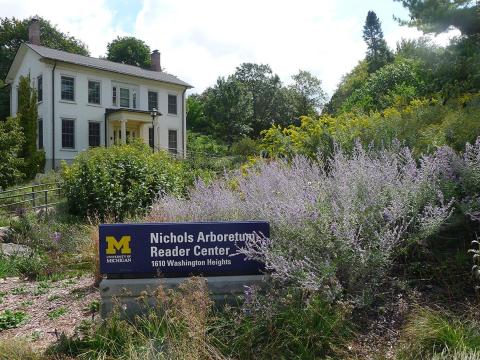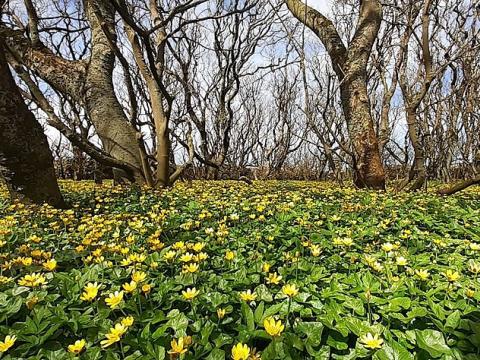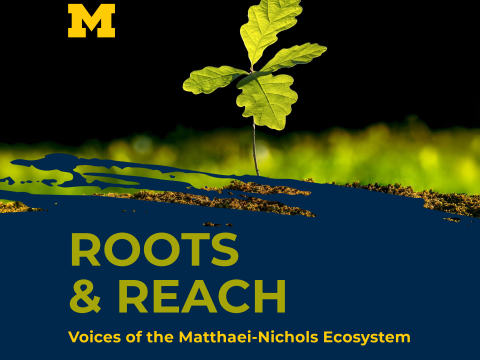
Timothy Cernak stands in front of a Chinese hemlock tree. Photo credit: Hsin-Ting Yeh
Walking through the shady forest of oak, maple, and other hardwood trees in Ann Arbor’s Bird Hills Nature Area already evokes a feeling of verdant quiet that grows stronger when the trail leads into a stand of eastern hemlock. There are only a few individuals, but the hemlocks’ needles deepen the shade and only allow a few rays of sunlight to reach the forest floor. The air is filled with a sylvan fragrance derived from molecules emitted by the hemlocks’ living needles and decaying leaf litter.
Those same molecules may hide the key to protecting these and other hemlock trees across eastern North America.
The hemlocks of eastern North America are threatened by the hemlock woolly adelgid (HWA), an invasive, sap-sucking bug that was introduced to the eastern United States from Japan in 1951. Because HWA is a nonnative species, there are no natural predators to control its population size in eastern North America, and the region’s hemlocks haven’t evolved any resistance against it, so eastern hemlocks can be sucked dry by severe HWA infestations. Hemlock trees sickened by HWA will turn gray, dry out, shed their leaves, and eventually die within four to fifteen years.
Timothy Cernak — an assistant professor from the University of Michigan’s Chemistry Department and College of Pharmacy — is working to develop better strategies to control the spread of HWA, which he views as a disease of hemlock forests. As a member of the College of Pharmacy, Cernak’s expertise is treating human disease using pharmaceuticals, but he is now applying the same principles of precision medicine to ask “what happens when a tree gets sick? What are the options?”

Improving precision medicine for the hemlock forest
In precision cancer medicine, doctors can prescribe medicines that are designed to treat specific cancer mutations. These selective drugs are less stressful on the body than traditional chemotherapy, which indiscriminately damages cells across the body.
However, hemlock forests today are stuck with broad, indiscriminate treatments. The State of Michigan recommends treating sickened trees with synthetic insecticides such as imidacloprid and dinotefuran. The toxic effects of these insecticides aren’t specific to adelgids, so they must be carefully applied so they are not exposed to native and beneficial insects. Safe treatments of HWA using these insecticides are possible, but they are limited to hammering insecticide-laden stakes into tree trunks or applying low amounts of liquid insecticide at the base of the tree. Such methods are difficult or impossible to scale up to infestations over large areas. Unfortunately, HWA is now found in around half of the eastern hemlock tree’s native range, where it has killed an enormous number of trees.
“In an ideal world, we’d be able to fly a plane over a forest and spray out medicine that is hyper-specific to HWA to deal with this infestation, but that’s not possible right now,” said Cernak, whose research aims to bring precision medicine to the forest.
Hemlock species from East Asia and western North America have co-evolved alongside adelgids for millions of years. These trees are impacted by feeding adelgids, but they aren’t decimated the way that eastern hemlocks are. Cernak is looking to these HWA-resistant hemlocks to protect the more vulnerable hemlocks in eastern North America. The key could be hidden in the suite of organic chemicals inside the resistant hemlocks’ leaves and bark because many plants produce compounds to resist and repel insects that would otherwise view them as a tasty snack. Molecules that are present at different amounts inside resistant and vulnerable hemlock species could stand out as natural alternatives to broad-spectrum insecticides, serve as adelgid repellent, or as hallmarks of a resistant hemlock that could be bred into hybrid trees for planting into damaged forests, Cernak said.
Protecting culturally and ecologically important hemlocks
The research is a race against the spread of HWA, which has steadily progressed eastward since it was first discovered in Richmond, Virginia. The bug is already present in some western counties in Michigan’s Lower Peninsula and was recently discovered in the Nichols Arboretum. Although Cernak and Kannan see potential in the molecular arsenal of hemlock species from Asia, they caution that it will take years before they can develop insecticides that specifically target HWA, and Cernak worries that HWA could harm ecologically and culturally important hemlock stands in Michigan before they can develop more precise insecticides.
Hemlocks don’t naturally grow in southeast Michigan, but some HWA-sensitive hemlock species – specifically eastern and Carolina hemlocks – were planted as part of the original landscape design for the Nichols Arboretum because their dense foliage creates a deep shade that effectively blocks wind and noise, which enhances the sense of tall hills and deep valleys, said Jeff Plakke, the MBGNA Natural Areas Program Lead.
“To me, hemlock trees create a sense of peace, quiet, solitude, and privacy that few other trees can match,” said Plakke.
Another culturally important hemlock stand is in Ann Arbor’s Bird Hills Nature Area. Hemlocks were planted there in the early 1900s before the land became a city park, said Becky Hand, a stewardship specialist with the Ann Arbor Natural Area Preservation. Park officials continue to keep this ornamental treasure standing for visitors to enjoy. One of the hemlock stands has “a big fort that I assume kids and other park users have built over the years,” said Hand, who added that “it’s a place where people like to go and play and explore nature.”
Today, the preservation of such hemlock stands requires staying vigilant about the spread of HWA. “Because [HWA] has been found so close by, I would say that we are concerned. We are educating all of our field staff about what to look for so that when they are out and about they can keep their eyes open for it,” Hand said. She added that Ann Arbor Natural Area Preservation would coordinate any HWA treatment with the City’s forestry department if HWA ever appeared in a city park.
Treating HWA in Michigan is not just about protecting a small collection of local trees. There are an estimated 145 million hemlock trees in Michigan, according to a 2011 Forest Inventory and Analysis report, where they are native to Michigan’s Upper Peninsula and the northern-most parts of the State’s Lower Peninsula. There, dense, old-growth hemlock forests block sunlight from reaching the forest floor, creating cool, shady habitats whose majesty some describe as “cathedral-like.” When hemlocks forests are cleared, deciduous hardwood forest usually take their place, so HWA could remove unique habitat from Michigan if left to spread unchecked.
A number of different species depend on shady hemlock forests, and their populations could be harmed if HWA wipes out their preferred habitat. Several birds found in northern Michigan — including the black-throated green warbler, blackburnian warbler, winter wren, red-breasted nuthatch, and blue-headed vireo — prefer to nest in hemlock forests, and their numbers decline wherever HWA hits hemlocks hard. Cold-water fish, like brook trout similarly decline without hemlock trees, whose shade prevents streams from warming in the sun.
Preventing HWA from reaching these important hemlock forests is vital to protect Michigan’s ecosystems, and treating HWA in southern Michigan before it can reach more sensitive ecosystems to the north is a critical part of stopping any further spread. For now, that means carefully applying broad-spectrum insecticides, said Cernak, which he equates with using chemotherapy in the fight against cancer.
“Today we would work with precision cancer drugs that target a very specific mutation within a cancer, yet we still sometimes blast people with chemotherapy to get rid of most of the cancer. That’s a very taxing treatment that is completely non-selective, but sometimes there’s no alternative,” Cernak said.
Derek Smith tells stories about science and the natural world for a wide audience. He has written for institutions, blogs, and in magazines as a freelancer, intern, and volunteer. His writing has been featured in the ScienceBites blogs and the Matthaei Botanical Gardens and Nichols Arboretum newsletter.




